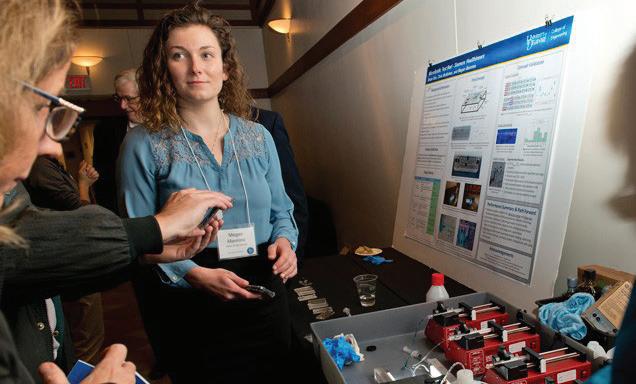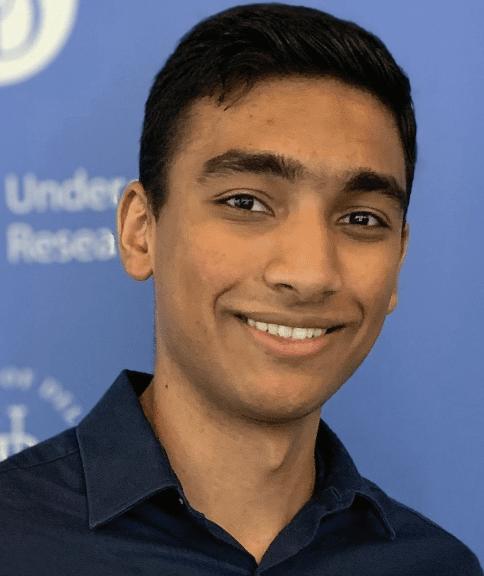
4 minute read
TEACHING AND OUTREACH
THRIVING IN A REAL WORLD ENVIRONMENT Students flex their skills through Senior Design
UD engineering student Megan Mannino and her teammates built a microfluidics technology testbed in partnership with sponsor Siemens Healthineers Diagnostics.
Megan Mannino, a 2019 alumna of our undergraduate program, was intrigued by microfluidics—the study of fluid behavior at a submillimeter scale—when she first learned about the subject during a technical engineering elective course.
For her final project before graduating, Mannino and two classmates built a microfluidics technology testbed to help Siemens Healthineers Diagnostics explore the feasibility of utilizing microfluidics technology in highthroughput clinical analyzers.
Clinical analyzers evaluate samples of bodily fluid. Perhaps your doctor draws blood to check your cholesterol levels or asks you to urinate in a cup to check for a urinary tract infection. The fluid goes into a clinical analyzer, which mixes it with reagents to determine if it is normal.
The trouble is that clinical analyzers are huge, taking up one or more rooms of many healthcare facilities. “Hospitals are already low on space, as well as people, to do these tests,” said Mannino. “Microfluidics could revolutionize healthcare.”
Using pumps, an imaging system, and specially designed acrylic chips, Mannino’s team built a testbed that merged water-based and oil-based fluid droplets, one by one. With more research, a similar device could be developed to merge individual drops of blood, plasma, or urine with individual drops of reagent, allowing for meaningful analysis of patient samples.
In December, the team explained their device to a room full of people, including expert judges. It was all part of Senior Design, a six-credit interdisciplinary capstone engineering course.
“Senior Design has probably been the most valuable part of my undergraduate degree,” said Mannino. During the fall semester of 2019, Senior Design brought together 141 students, including all seniors majoring in biomedical engineering and mechanical engineering as well as some students majoring in electrical and computer engineering and civil and environmental engineering. Students were divided into 36 teams guided by 13 faculty advisors.
Projects were sponsored by industrial, clinical and academic partners.
“What stood out most in senior design this year was the excellent interdisciplinary integration and teamwork, which enabled engineering seniors to make the best possible prototypes in the shortest possible time,” said Ashutosh Khandha, an assistant professor of biomedical engineering. “It was exhilarating to see students working with industry, business and clinical sponsors, and thriving in a real-world environment.”

DRIVEN TO DISCOVER: ARIF PERACHA

Arif Peracha, a recent alumnus of our undergraduate program, was one of more than 500 students doing research across UD during the summer of 2019. At UD, he was also a McNair Scholar and triathlete. He participated in a Q&A about his experience spending a summer in a UD lab.
Q. What have you been studying this summer?
Peracha: I am at the STAR (Science, Technology and Advanced Research) Campus, working in the Muscle and Tendon Performance Lab with Dr. Karin Silbernagel, associate professor of physical therapy. My project is studying whether leg dominance is correlated with different mechanical properties of the Achilles tendon in healthy subjects, such as how stiff it is and how well it behaves like a spring in response to forces. As the Achilles tendon responds at the cellular level to forces and loading to heal, reinforce itself and improve its mechanical properties, it may be possible that consistently using a dominant leg for tasks could have formed differences between the dominant to nondominant side.
Q. What inspired this project and what interests you most about it?
Peracha: As a runner, the fact that Achilles tendinopathy is a very common occurrence in runners makes the Achilles tendon a topic of interest for me. I also aspire to be a physical therapist and — dreaming big — if this research helps clinicians better understand how important limb dominance is to the Achilles tendon it may aid in making decisions about when people should be cleared for activities after Achilles tendinopathy. For example, if it is found that the dominant leg has stiffer properties in the tendon, a physical therapist may have to tell a soccer player who has injured the tendon on that side that it needs to be rehabilitated to better mechanical properties than the non-dominant side before the player can safely return to the field.
Read more at: www.udel.edu/007767
Akram Ahamed, an undergraduate biomedical engineering and Honors College student, spent the summer of 2019 as a Delaware INBRE summer scholar under the guidance of Dr. Jennifer Goldstein at ChristianaCare.
Ahamed was part of a research group that quantified and characterized illegal advertisements on Craigslist for the prescription medications insulin, albuterol and epinephrine. He was the first author of a Research Letter published in JAMA Internal Medicine in 2020 reporting that the group found 432 advertisements for insulin and albuterol in a 12day period and studied pricing and seller motivations.



